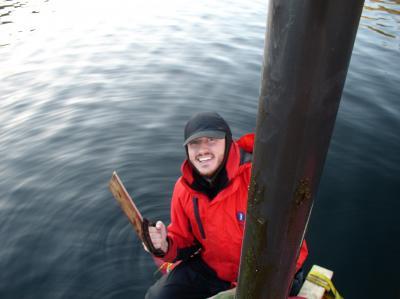The race is on to blame everything related to ecological change on human footprints - even the past can be re-framed as anthropocenic climate change and University of Massachusetts Amherst geoscientists have shown how to do just that, by using a biomarker from human feces in a completely new way to establish the first human presence, the arrival of grazing animals and human population dynamics in a landscape.
Paleoclimatologists have long used markers in lakebed sediments, such as charcoal from humans' fires and pollen from cultivated plants, as a natural archive of environmental changes to estimate when humans first began having an impact. But these indirect indicators must be used with care when reconstructing the history of a place because it's not always clear that they indicate human activity in the same area.
They carried out their work just north of the Arctic Circle, at Lake Liland in the Lofoten Islands in northern Norway, where humans were thought to have lived in prehistoric settlements from the early Iron Age through the Viking period. They extracted two sediment cores from the lake bottom and used radiocarbon measurements and the presence of volcanic ash from Iceland to establish their chronology. The sediments provided a continuous record extending back roughly 7,000 years.

UMass Amherst geoscience doctoral student Rob D'Anjou extracted sediment cores from an Arctic lake bed to date the onset of human activity in the area. Credit: UMass Amherst
By contrast, the presence of a molecular biomarker directly linked to humans, one transmitted through their bowel movements, offers "a strong human signal," as the authors put it, one that can be dated with "excellent chronological control." They extracted the compound coprostanol, a molecular marker formed from the digestion of cholesterol in the human gut, from the sediment, plus other sterols characteristic of other mammals to estimate the presence of sheep and cattle. From these, they were able to produce a long-term record of the presence and relative population size of humans extending back over thousands of years at the site.
In addition, the geoscientists used two other molecular markers to reconstruct the vegetation history: relative length of carbon molecules found in leaf waxes (different in forest and grassland), and pyrolytic polycyclic aromatic hydrocarbons (PAH) as evidence of fire in the Lake Liland area. They say that taken together, the sediment cores, vegetation changes and fire records clearly define a pre-settlement period with no detectable human activity in the lake's water catchment area from about 7,300 to 2,250 years ago.
At that point, however, changes in the background state appear in the record, marking an "abrupt shift" to significantly increased levels of pyrolytic PAH first, followed by increased human fecal material. This likely indicates that as people moved in, they first cleared the land by burning before establishing a permanent settlement, the researchers say. "This interpretation is bolstered," they add, by the leaf wax record that shows a "marked transition to a more grassland-dominated landscape beginning at this time."
After the initial influx of people to the region, they say the record shows a lull in human activity from about 2,040 to 1,900 years ago, reflected in all markers. After this, the human and livestock populations steadily increased to a local maximum around the year 500, based on the fecal record, then fell again to a second minimum around the year 850.
The climate scientists note a further decline in human activity and population to another minimum at about 1750 A.D. that coincided with the highest relative grassland cover for the entire 7,300-year history. Findings related to human activity over the past 7,300 years in northern Norway correlate well with other climate reconstructions, in particular summer temperature patterns indicating poor vs. fruitful growing seasons. This shows that the early settlers were vulnerable to small changes in summer temperature at this far northern location.
Overall, the authors say, the new fecal markers are likely to prove valuable in many other places, to distinguish natural from human factors that influenced the environment in the past.





Comments